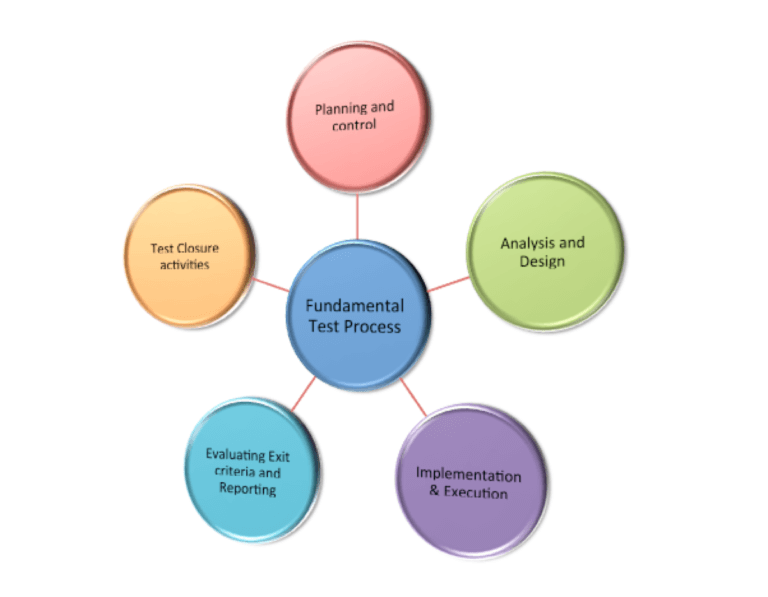Testing Foundation
What is Software Testing?
Objective of Testing
Why is testing necessary?
Common Terms used in Testing
Verification Vs Validations
QA Vs QC
Debugging Vs Testing
Seven Testing Principles
SDLC Vs STLC
Fundamentals of Test Process
Software quality Factors
Software Development Models
Waterfall Model
V models
Iterative Model
Test Levels
Component Testing
Integration Testing
System Testing
Acceptance Testing
Strategies for Integration Testing
Big Bang
Stubs and Driver
Top Down Testing
Bottom Up Testing
Test Types
Functional Testing
Non- Functional Testing
Structural Testing
Re-testing & Regression Testing
Static AND Dynamic Techniques
Static Technique
Dynamic Technique
Static Analysis by Tools
White Box Techniques
Statement Coverage Testing
Branch Coverage Testing
Decision Coverage Testing
Path Coverage
Black Box Techniques
Equivalence Partitioning
Boundary Value Analysis
Decision Table testing
State Transition testing
Experience Based TestingTechniques
Random Testing
Exploratory Testing
Error Guessing
Functional Testing
Integration Testing
Unit Testing
System Testing
Smoke testing
Sanity testing
Regression Testing
Usability Testing
Security Testing
User Acceptance Testing
White Box & Black Box Testing
Globalization & Localization Testing
Non Functional Testing
Compatibility testing
Endurance testing
Load testing
Performance testing
Recovery testing
Scalability testing
Stress testing
Volume testing
Test Planning and Estimation
Test Planning
Test Strategies Vs Test Plan
Test Approaches
Risk and Testing
Product Risks
Project Risks
Defect Management
Defect LifeCycle
Severity Vs Priority
Test Process :Fundamentals and Testing activities
Complete test process involves various activities starting from Planning to Test Closure activities. The quality and effectiveness of software testing are determined by how effectively the testing processes are used.
The Test Process activities are:
- Planning and Control
- Analysis and Design
- Implementation and Execution
- Evaluating test exit criteria and Reporting
- Test Closure activities

Planning :
Planning includes :
-
-
- Defining testing objectives
- Test activities specified to meet the objectives and goals
- Planning determines scope, risks, test approach, test strategy.
-
Control :
-
-
- Continuous ongoing activity to compare actual progress with plan
- Measure , analyse and report the status, including deviations from plan
- Initiate necessary actions to meet objectives
- You can’t control testing without monitoring.Planning takes into account feedback from monitoring and control
-
Analysis and Design:
The requirements are transformed to test conditions and test cases.
Analysis and Design phase of testing includes:
-
-
- Review the test basis and understand the software specifications (such as requirements, architecture, design and interface)
- Evaluate test-ability of requirements to specify expected results and make sure requirements can be verified.
- Identify and prioritize Test conditions
- Design high level test cases and prioritize
- Identify test data
- Design test environment and identify any tool or infrastructure required for testing the software.
- Create bi-directional traceability between test basis and test cases
-
Test Implementation and Execution:
All high level designing till this phase is now built in test cases and test procedures.
Test Implementation and Execution phase of testing includes:
-
-
- Develop and prioritize tests cases
- Develop test procedures , test suites( logical collection of test cases)
- Create test data
- Set up test environment and verify that it is ready for test execution
- Verify and update traceability
- Execute test procedures
- Log the outcome of each execution and compare actual with expected results
- Report discrepancies and provide additional information to establish if likely cause is defect in code, test data, test document
- Retest after the defect is fixed (confirmation testing) and perform regression testing
-
Evaluating test exit criteria and Reporting:
Based on the risk assessment for each test level, exit criteria is defined beforehand defining when to stop testing.Evaluation of exit criteria comes when maximum test cases are executed with specific pass percent or defect ratio below a certain level.
Evaluation exit criteria and Reporting phase of testing includes:
-
-
- Check test logs against exit criteria in test planning and identify what is remaining to test or fix
- Assess if more tests are needed or if the initial exit criteria needs to be modified
- Write a test summary report for stakeholders
-
Test Closure Activities:
Ending testing includes various activities to collect data from completed test activities and consolidate experience, test ware, facts and numbers.
Test Closure activities phase of testing includes:
-
-
- Ensure that planned deliverable has been delivered.
- Ensure Incident reports are resolved or marked deferred
- Documenting acceptance of the system
- Finalize and archive test ware, test environment and infrastructure for reuse
- Hand over test ware to maintenance team
- Evaluate lessons learnt to determine changes needed for future releases and projects Use information gathered to improve test maturity
-
Recommended Articles:
Testing Foundation
What is Software Testing?
Objective of Testing
Why is testing necessary?
Common Terms used in Testing
Verification Vs Validations
QA Vs QC
Debugging Vs Testing
Seven Testing Principles
SDLC Vs STLC
Fundamentals of Test Process
Software quality Factors
Software Development Models
Waterfall Model
V models
Iterative Model
Test Levels
Component Testing
Integration Testing
System Testing
Acceptance Testing
Strategies for Integration Testing
Big Bang
Stubs and Driver
Top Down Testing
Bottom Up Testing
Test Types
Functional Testing
Non- Functional Testing
Structural Testing
Re-testing & Regression Testing
Static AND Dynamic Techniques
Static Technique
Dynamic Technique
Static Analysis by Tools
White Box Techniques
Statement Coverage Testing
Branch Coverage Testing
Decision Coverage Testing
Path Coverage
Black Box Techniques
Equivalence Partitioning
Boundary Value Analysis
Decision Table testing
State Transition testing
Experience Based TestingTechniques
Random Testing
Exploratory Testing
Error Guessing
Functional Testing
Integration Testing
Unit Testing
System Testing
Smoke testing
Sanity testing
Regression Testing
Usability Testing
Security Testing
User Acceptance Testing
White Box & Black Box Testing
Globalization & Localization Testing
Non Functional Testing
Compatibility testing
Endurance testing
Load testing
Performance testing
Recovery testing
Scalability testing
Stress testing
Volume testing
Test Planning and Estimation
Test Planning
Test Strategies Vs Test Plan
Test Approaches
Risk and Testing
Product Risks
Project Risks
Defect Management
Defect LifeCycle
Severity Vs Priority
